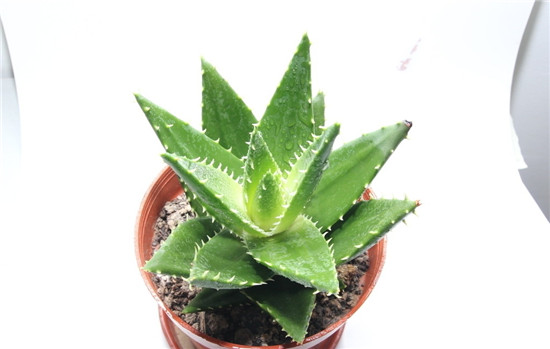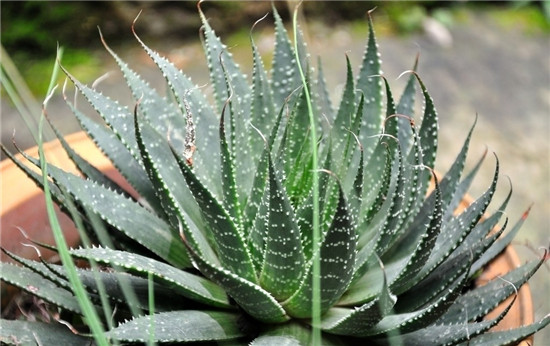What are the culture methods of aloe?
Aloe vera, also known as Luhui, elephant gallbladder and slave society, is a common plant in our daily life, which is not only ornamental but also edible. Next, let's take a look at its breeding methods.

Family potted aloe is different from outdoor planting, its growth environment is only in narrow potted plants. In order to meet the requirements of various environmental conditions such as water, fertilizer, gas and heat in the process of aloe root growth and development, selecting various suitable substrates and scientifically preparing basin soil is very important to promote the normal development and growth of aloe.
The main culture methods of aloe are as follows:
1. Preparation of basin soil: the ratio of commonly used basin soil formula for humus, garden loam and river sand (sawdust or cooked coal ash) is 2:2:1. The most suitable growth substrate requires pHWEI6.8-7.0pH. At ordinary times, attention should be paid to the cleanliness and hygiene of basin soil, frequent disinfection and sterilization.
2. Selection of pots: according to the texture of flowerpots, there are earthen pots, purple sand pots, porcelain pots, plastic pots, etc., according to personal preferences and aesthetic taste, choose suitable flowerpots to grow. The mud basin with good air permeability is the most suitable for the cultivation of aloe.

3. Upper basin and change basin of basin soil: the key is to select seedlings before going up the basin, the upper basin should be carried out in spring and summer, and the suitable indoor temperature is 15 ℃-18 ℃. Potted aloe usually needs to change the pot once every 1-2 years, and the time to change the pot is from April to May in spring and from September to October in autumn.
4. Fertilization: try not to apply chemical fertilizer, but can apply organic fertilizer and inorganic fertilizer, the combination effect of both is better, there are two methods: base fertilizer and topdressing fertilizer.
5. Watering: aloe has strong drought resistance, so it should be watered rationally according to the necessary conditions of plant growth and development, so that it can be dry and wet, dry and thoroughly.
6. Overwintering management: in winter, the temperature should be kept above 5 ℃, move to indoor or greenhouse for overwintering, control watering and increase light.
Aloe is recorded as an "immortal plant" in ancient Egyptian herbal books. We can see that aloe has high medicinal value on the one hand, and is easy to breed on the other hand. So how can we better cultivate aloe?

Water: we often say that "water is the source of life". Although aloe is a plant growing in the desert, it is also inseparable from the moisture of water. When we water aloe, we should pay attention to seasonal changes, for example, we should prevent aloe from drought in summer, so it is best to water aloe once every 5 days or so, and we should also water aloe properly in autumn, usually once every 10 days.
Temperature: aloe is a tropical plant, so it likes to grow in warm places, so we should often bask aloe in the sun. If it is overcast or rainy or the climate is relatively low, it is best to keep it indoors. In this way, aloe vera will not catch cold.
Soil: can be properly fertilized to ensure the nutrients of aloe. At the same time, we should also pay attention to loosen the soil properly to avoid stagnant water or soil blockage causing aloe rotting roots.

Management and maintenance of aloe
The management of family potted aloe mainly includes fertilization, watering and heat preservation in winter.
Fertilization: aloe needs a large number of elements in the growth process, such as carbon, hydrogen, oxygen, nitrogen, phosphorus, potassium, sulfur, calcium, magnesium, iron and so on, in which carbon, hydrogen and oxygen come from the air, while other elements are absorbed from the pot substrate. In addition, boron, manganese, molybdenum, zinc, copper, chlorine and other elements are needed. Although the demand is small, they cannot be replaced by other elements. Scientific fertilization can supplement nutrition.
Watering: in winter, it can be watered once every 15-20 days, and foliar water can be sprayed if necessary. Watering as little as possible and keeping the basin soil dry is beneficial to the safety of the plant through the winter; in spring, it is usually watered once every 5-7 days. If it is not dry or irrigated, it will be watered thoroughly, and the basin soil will be dry and wet; in summer, the temperature is high and evaporation is large, which requires watering once every 2-3 days, and can spray water on the leaves of aloe vera every morning and evening. Also pay attention to less exposure to the hot sun, reduce the loss of water; in autumn, the watering method of aloe is basically similar to that of spring, so the basin soil should be dry and wet. The watering time is generally better in the early morning and evening, when the water temperature is close to the basin soil temperature, which can avoid the drastic change of the basin soil temperature and affect the root growth. Remember: "potted aloe would rather be dry than wet."
These are all the contents of the aloe culture methods that I have summarized for you. I hope this article can help you. Please continue to follow us.
Please continue to follow us.
Related
- Wuhan Hospital Iron Tree Blooming Result Was Instantly Frightened by the Gardener Master
- Which variety of camellia is the most fragrant and best? Which one do you like best?
- What is the small blue coat, the breeding methods and matters needing attention of the succulent plant
- Dormancy time and maintenance management of succulent plants during dormancy
- Minas succulent how to raise, Minas succulent plant pictures
- What are the varieties of winter succulent plants
- How to raise succulent plants in twelve rolls? let's take a look at some experience of breeding twelve rolls.
- Attention should be paid to water control for succulent plants during dormant period (winter and summer)
- Watering experience of twelve rolls of succulent plants
- Techniques for fertilizing succulent plants. An article will let you know how to fertilize succulent plants.



